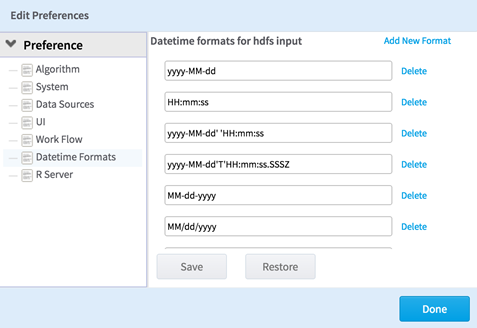Datetime Formats Preferences
Use the Datetime Formats Preferences to modify the appearance of dates and times in the Workflow Editor.
The Datetime formats are used by the Workflow Editor in the following cases:
- Using the Hadoop File Structure configuration to import datetime data from Hadoop File System text files. See the "Hadoop File" operator help in TIBCO® Data Science Team Studio User's Guide for details.
- Using the Pig Execute operator to execute Hadoop Pig script against datetime data fields and leverage Pig Datetime functions such as GetMonth(datetime) or GetDay(datetime). See the "Pig Execute" operator help in TIBCO® Data Science Team Studio User's Guide for details.
- Using the Variable operator to convert source datetime formats into new datetime formats or to convert datetime data into new data fields with a Pig DateTime function. See the "Variable" operator help in TIBCO® Data Science Team Studio User's Guide for details.
- Using the Set operator to combine two or more data sources that contain datetime data types. See the "Set Operations" in TIBCO® Data Science Team Studio User's Guide for details.
- Using the Null Value Replacement operator to replace null values with a default datetime format. See the "Null Value Replacement" operator help in TIBCO® Data Science Team Studio User's Guide for details.
- Using the Row Filter operator to filter data by datetime formats or by a value derived from an applied the Pig Datetime function. See the "Row Filter" operator help in TIBCO® Data Science Team Studio User's Guide for details.
Procedure
Copyright © 2021. Cloud Software Group, Inc. All Rights Reserved.

